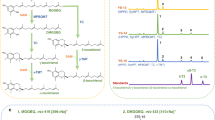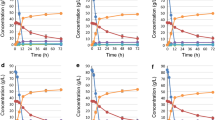Abstract
The yeast Ogataea thermomethanolica has recently emerged as a potential host for heterologous protein expression at elevated temperature. To evaluate the feasibility of O. thermomethanolica as heterologous host in large-scale fermentation, constitutive production of fungal phytase was investigated in fed-batch fermentation. The effect of different temperatures, substrate feeding strategies, and carbon sources on phytase production was investigated. It was found that O. thermomethanolica can grow in the temperature up to 40 °C and optimal at 34 °C. However, the maximum phytase production was observed at 30 °C and slightly decreased at 34 °C. The DOT stat control was the most efficient feeding strategy to obtain high cell density and avoid by-product formation. The table sugar can be used as an alternative substrate for phytase production in O. thermomethanolica. The highest phytase activity (134 U/mL) was obtained from table sugar at 34 °C which was 20-fold higher than batch culture (5.7 U/mL). At a higher cultivation temperature of 38 °C, table sugar can be used as a low-cost substrate for the production of phytase which was expressed with an acceptable yield (85 U/mL). Lastly, the results from this study reveal the industrial favorable benefits of employing O. thermomethanolica as a host for heterologous protein production.





Similar content being viewed by others
References
Haefner, S., Knietsch, A., Scholten, E., Braun, J., Lohscheidt, M., & Zelder, O. (2005). Biotechnological production and applications of phytases. Applied Microbiology and Biotechnology, 68(5), 558–597.
Promdonkoy, P., Tang, K., Sornlake, W., Harnpicharnchai, P., Kobayashi, R. S., Ruanglek, V., & Tanapongpipat, S. (2009). Expression and characterization of Aspergillus thermostable phytases in Pichia pastoris. FEMS Microbiology Letters, 290(1), 18–24.
Tanapongpipat, S., Promdonkoy, P., Watanabe, T., Tirasophon, W., Roongsawang, N., Chiba, Y., & Eurwilaichitr, L. (2012). Heterologous protein expression in Pichia thermomethanolica BCC16875, a thermotolerant methylotrophic yeast and characterization of N-linked glycosylation in secreted protein. FEMS Microbiology Letters, 334(2), 127–134.
Harnpicharnchai, P., Promdonkoy, P., Sae-Tang, K., Roongsawang, N., & Tanapongpipat, S. (2014). Use of the glyceraldehyde-3-phosphate dehydrogenase promoter from a thermotolerant yeast, Pichia thermomethanolica, for heterologous gene expression, especially at elevated temperature. Annals Microbiology, 64, 1457–1462.
Promdonkoy, P., Tirasophon, W., Roongsawang, N., Eurwilaichitr, L., & Tanapongpipat, S. (2014). Methanol-inducible promoter of thermotolerant methylotrophic yeast Ogataea thermomethanolica BCC16875 potential for production of heterologous protein at high temperatures. Current Microbiology, 69(2), 143–148.
Roongsawang, N., Puseenam, A., Kitikhun, S., Sae-Tang, K., Harnpicharnchai, P., Ohashi, T., & Tanapongpipat, S. (2016). A novel potential signal peptide sequence and overexpression of ER-resident chaperones enhance heterologous protein secretion in thermotolerant methylotrophic yeast Ogataea thermomethanolica. Applied Biochemistry and Biotechnology, 178(4), 710–724.
Bollok, M., Resina, D., Valero, F., & Ferrer, P. (2009). Recent patents on the Pichia pastoris expression system: expanding the toolbox for recombinant protein production. Recent Patents on Biotechnology, 3(3), 192–201.
Garcia-Ortega, X., Ferrer, P., Montesinos, J. L., & Valero, F. (2013). Fed-batch operational strategies for recombinant Fab production with Pichia pastoris using the constitutive GAP promoter. Biochemical Engineering Journal, 79, 172–181.
Guan, B., Chen, F., Lei, J., Li, Y., Duan, Z., Zhu, R., & Jin, J. (2013). Constitutive expression of a rhIL-2-HSA fusion protein in Pichia pastoris using glucose as carbon source. Applied Biochemistry and Biotechnology, 171(7), 1792–1804.
Wang, X., Sun, Y., Ke, F., Zhao, H., Liu, T., Xu, L., & Yan, Y. (2012). Constitutive expression of Yarrowia lipolytica lipase LIP2 in Pichia pastoris using GAP as promoter. Applied Biochemistry and Biotechnology, 166(5), 1355–1367.
Wang, Q., Du, W., Weng, X.-Y., Liu, M.-Q., Wang, J.-K., & Liu, J.-X. (2015). Recombination of thermo-alkalistable, high xylooligosaccharides producing endo-xylanase from Thermobifida fusca and expression in Pichia pastoris. Applied Biochemistry and Biotechnology, 175(3), 1318–1329.
Heo, J. H., Hong, W. K., Cho, E. Y., Kim, M. W., Kim, J. Y., Kim, C. H., & Kang, H. A. (2003). Properties of the Hansenula polymorpha-derived constitutive GAP promoter, assessed using an HSA reporter gene. FEMS Yeast Research, 4(2), 175–184.
Waterham, H. R., Digan, M. E., Koutz, P. J., Lair, S. V., & Cregg, J. M. (1997). Isolation of the Pichia pastoris glyceraldehyde-3-phosphate dehydrogenase gene and regulation and use of its promoter. Gene, 186(1), 37–44.
Döring, F., Klapper, M., Theis, S., & Daniel, H. (1998). Use of the glyceraldehyde-3-phosphate dehydrogenase promoter for production of functional mammalian membrane transport proteins in the yeast Pichia pastoris. Biochemical and Biophysical Research Communications, 250(2), 531–535.
Delroisse, J. M., Dannau, M., Gilsoul, J. J., El Mejdoub, T., Destain, J., Portetelle, D., & Vandenbol, M. (2005). Expression of a synthetic gene encoding a Tribolium castaneum carboxylesterase in Pichia pastoris. Protein Expression and Purification, 42(2), 286–294.
Zhang, A. L., Zhang, T. Y., Luo, J. X., Chen, S. C., Guan, W. J., Fu, C. Y., & Li, H. L. (2007). Constitutive expression of human angiostatin in Pichia pastoris by high-density cell culture. Journal of Industrial Microbiology and Biotechnology, 34(2), 117–122.
Riesenberg, D., & Guthke, R. (1999). High-cell-density cultivation of microorganisms. Applied Microbiology and Biotechnology, 51(4), 422–430.
Jahic, M., Wallberg, F., Bollok, M., Garcia, P., & Enfors, S.-O. (2003). Temperature limited fed-batch technique for control of proteolysis in Pichia pastoris bioreactor cultures. Microbial Cell Factories, 2, 6.
Davis, R., Duane, G., Kenny, S. T., Cerrone, F., Guzik, M. W., Babu, R. P., & O’Connor, K. E. (2015). High cell density cultivation of Pseudomonas putida KT2440 using glucose without the need for oxygen enriched air supply. Biotechnology and Bioengineering, 112(4), 725–733.
Castan, A., & Enfors, S.-O. (2000). Characteristics of a DO-controlled fed-batch culture of Escherichia coli. Bioprocess Engineering, 22, 509–515.
Renouf, M. A., Wegener, M. K., & Nielsen, L. K. (2008). An environmental life cycle assessment comparing Australian sugarcane with US corn and UK sugar beet as producers of sugars for fermentation. Biomass and Bioenergy, 32(12), 1144–1155.
Abdel-Banat, B. M. A., Hoshida, H., Ano, A., Nonklang, S., & Akada, R. (2010). High-temperature fermentation: how can processes for ethanol production at high temperatures become superior to the traditional process using mesophilic yeast? Applied Microbiology and Biotechnology, 85(4), 861–867.
Bruschi, M., Krömer, J. O., Steen, J. A., & Nielsen, L. K. (2014). Production of the short peptide surfactant DAMP4 from glucose or sucrose in high cell density cultures of Escherichia coli BL21(DE3). Microbial Cell Factories, 13, 99.
Limtong, S., Srisuk, N., Yongmanitchai, W., Yurimoto, H., & Nakase, T. (2008). Ogataea chonburiensis sp. nov. and Ogataea nakhonphanomensis sp. nov., thermotolerant, methylotrophic yeast species isolated in Thailand, and transfer of Pichia siamensis and Pichia thermomethanolica to the genus Ogataea. International Journal of Systematic and Evolutionary Microbiology, 58(1), 302–307.
Eilert, E., Hollenberg, C. P., Piontek, M., & Suckow, M. (2012). The use of highly expressed FTH1 as carrier protein for cytosolic targeting in Hansenula polymorpha. Journal of Biotechnology, 159(3), 172–176.
Jahic, M., Rotticci-Mulder, J., Martinelle, M., Hult, K., & Enfors, S.-O. (2002). Modeling of growth and energy metabolism of Pichia pastoris producing a fusion protein. Bioprocess and Biosystems Engineering, 24(6), 385–393.
Antimanon, S., Charoenrat, T., Kocharin, K., Tanapongpipat, S., & Roongsawang, N. (2016). Growth and recombinant phytase production of Ogataea thermomethanolica. Thai Science and Technology Journal, 24(1), 49–63.
Engelen, A. J., van der Heeft, F. C., Randsdorp, P. H., & Smit, E. L. (1994). Simple and rapid determination of phytase activity. Journal of AOAC International, 77(3), 760–764.
Bradford, M. (1976). Rapid and sensitive method for quantification of microgram quantities of protein utilizing principle of protein-dye-binding. Analytical Biochemistry, 72(1-2), 248–254.
Cos, O., Ramón, R., Montesinos, J. L., & Valero, F. (2006). Operational strategies, monitoring and control of heterologous protein production in the methylotrophic yeast Pichia pastoris under different promoters: a review. Microbial Cell Factories, 5(1), 17.
Raimondi, S., Zanni, E., Amaretti, A., Palleschi, C., Uccelletti, D., & Rossi, M. (2013). Thermal adaptability of Kluyveromyces marxianus in recombinant protein production. Microbial Cell Factories, 12(1), 34.
Zhong, Y., Yang, L., Guo, Y., Fang, F., Wang, D., Li, R., & Xiao, W. (2014). High-temperature cultivation of recombinant Pichia pastoris increases endoplasmic reticulum stress and decreases production of human interleukin-10. Microbial Cell Factories, 13(1), 163..
Zhang, Y., Liu, R., & Wu, X. (2007). The proteolytic systems and heterologous proteins degradation in the methylotrophic yeast Pichia pastoris. Annals of Microbiology, 57(4), 553–560.
Inan, M., & Meagher, M. M. (2001). The effect of ethanol and acetate on protein expression in Pichia pastoris. Journal of Bioscience and Bioengineering, 92(4), 337–341.
Enfors, S.-O., & Haggstrom, L. (2000). Bioprocess technology: fundamentals and applications. Syockholm: Royal Institute of Technology.
Charoenrat, T., Ketudat-Cairns, M., Jahic, M., Veide, A., & Enfors, S. O. (2006). Increased total air pressure versus oxygen limitation for enhanced oxygen transfer and product formation in a Pichia pastoris recombinant protein process. Biochemical Engineering Journal, 30(2), 205–211.
De Maré, L., Andersson, L., & Hagander, P. (2003). Probing control of glucose feeding in Vibrio cholerae cultivations. Bioprocess and Biosystems Engineering, 25(4), 221–228.
Çalık, P., Ata, Ö., Güneş, H., Massahi, A., Boy, E., Keskin, A., & Özdamar, T. H. (2015). Recombinant protein production in Pichia pastoris under glyceraldehyde-3-phosphate dehydrogenase promoter: from carbon source metabolism to bioreactor operation parameters. Biochemical Engineering Journal, 95, 20–36.
Wetzel, D., Müller, J. M., Flaschel, E., Friehs, K., & Risse, J. M. (2016). Fed-batch production and secretion of streptavidin by Hansenula polymorpha: evaluation of genetic factors and bioprocess development. Journal of Biotechnology, 225, 3–9.
Acknowledgments
We are grateful to Dr. Philip J. Shaw for critically editing the manuscript. Financial support (P-13-50136, P-14-50939) from the National Center for Genetic Engineering and Biotechnology, National Science and Technology Development Agency, Thailand, is greatly appreciated. We also acknowledge Central Scientific Instrument Center, Faculty of Science and Technology, Thammasat University, Thailand, for kindly supporting the use of their HPLC.
Author information
Authors and Affiliations
Corresponding author
Rights and permissions
About this article
Cite this article
Charoenrat, T., Antimanon, S., Kocharin, K. et al. High Cell Density Process for Constitutive Production of a Recombinant Phytase in Thermotolerant Methylotrophic Yeast Ogataea thermomethanolica Using Table Sugar as Carbon Source. Appl Biochem Biotechnol 180, 1618–1634 (2016). https://doi.org/10.1007/s12010-016-2191-8
Received:
Accepted:
Published:
Issue Date:
DOI: https://doi.org/10.1007/s12010-016-2191-8




